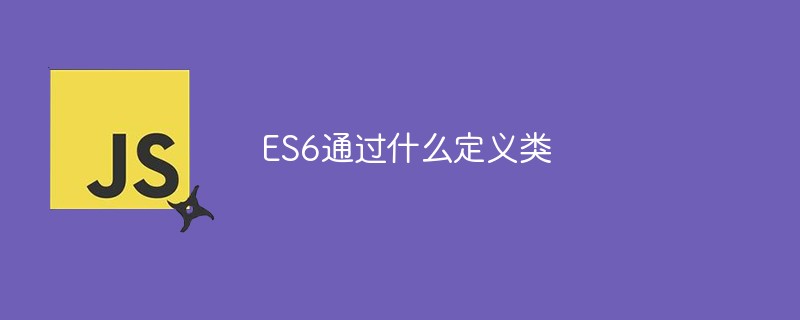ES6에서는 클래스를 어떻게 정의하나요?
- 青灯夜游원래의
- 2022-03-09 18:52:281618검색
ES6에서는 객체에 대한 템플릿으로 클래스(class)가 도입되었으며, "class" 키워드를 통해 클래스를 정의할 수 있습니다. 클래스의 본질은 함수입니다. 이는 구문 설탕으로 간주될 수 있으며 객체 프로토타입 작성을 더 명확하고 객체 지향 프로그래밍의 구문과 더 유사하게 만듭니다.

이 튜토리얼의 운영 환경: Windows 7 시스템, ECMAScript 버전 6, Dell G3 컴퓨터.
ES6 Class
ES6에서는 클래스(class)가 객체의 템플릿으로 도입되었으며 클래스는 "class" 키워드를 통해 정의할 수 있습니다.
수업의 본질은 기능입니다.
기본적으로 ES6 클래스는 단지 구문 설탕으로 간주될 수 있습니다. 대부분의 기능은 ES5에서 달성할 수 있습니다. 새로운 클래스 작성 방법은 객체 프로토타입의 작성 방법을 더 명확하고 객체 지향 프로그래밍의 구문과 더 유사하게 만듭니다. .
기본 사용법
클래스 정의
클래스 표현식은 익명이거나 이름이 지정될 수 있습니다.
// 匿名类
let Example = class {
constructor(a) {
this.a = a;
}
}
// 命名类
let Example = class Example {
constructor(a) {
this.a = a;
}
}클래스 선언
class Example {
constructor(a) {
this.a = a;
}
}주의 사항: 반복 가능한 선언은 허용되지 않습니다.
class Example{}
class Example{}
// Uncaught SyntaxError: Identifier 'Example' has already been
// declared
let Example1 = class{}
class Example{}
// Uncaught SyntaxError: Identifier 'Example' has already been
// declared주의 사항:
클래스 정의는 승격되지 않습니다. 즉, 액세스하기 전에 클래스를 정의해야 하며 그렇지 않으면 오류가 보고됩니다.
클래스의 메서드에는 function 키워드가 필요하지 않습니다.
메소드 사이에는 세미콜론이 없습니다.
new Example();
class Example {}클래스 본문
Properties
prototype
ES6에서는 메소드가 클래스에서 직접 정의될 수 있지만 실제로는 프로토타입에 정의되어 있습니다. 초기화 시 메소드 재정의/메서드 추가
Example.prototype={
//methods
}Add 메소드
Object.assign(Example.prototype,{
//methods
})정적 속성
정적 속성: 클래스 자체의 속성, 즉 클래스 내부에 직접 정의된 속성(Class.propname)은 반드시 그럴 필요는 없습니다. 인스턴스화되었습니다. ES6에서는 Class 내부에 정적 메서드만 있고 정적 속성은 없다고 규정합니다.
class Example {
// 新提案
static a = 2;
}
// 目前可行写法
Example.b = 2;공용 속성
class Example{}
Example.prototype.a = 2;인스턴스 속성
인스턴스 속성: 인스턴스 객체(this)에 정의된 속성입니다.
class Example {
a = 2;
constructor () {
console.log(this.a);
}
}name attribute
클래스 다음에 오는 클래스 이름을 반환합니다(존재하는 경우).
let Example=class Exam {
constructor(a) {
this.a = a;
}
}
console.log(Example.name); // Exam
let Example=class {
constructor(a) {
this.a = a;
}
}
console.log(Example.name); // Examplemethod
constructor method
constructor 메서드는 클래스의 기본 메서드이며 클래스의 인스턴스화된 개체를 생성할 때 호출됩니다.
class Example{
constructor(){
console.log('我是constructor');
}
}
new Example(); // 我是constructor반환 객체
class Test {
constructor(){
// 默认返回实例对象 this
}
}
console.log(new Test() instanceof Test); // true
class Example {
constructor(){
// 指定返回对象
return new Test();
}
}
console.log(new Example() instanceof Example); // false정적 메소드
class Example{
static sum(a, b) {
console.log(a+b);
}
}
Example.sum(1, 2); // 3프로토타입 메소드
class Example {
sum(a, b) {
console.log(a + b);
}
}
let exam = new Example();
exam.sum(1, 2); // 3인스턴스 메소드
class Example {
constructor() {
this.sum = (a, b) => {
console.log(a + b);
}
}
}클래스 인스턴스화
new
클래스는 다음을 통해 인스턴스화되어야 합니다. 새로운 키워드.
class Example {}
let exam1 = Example();
// Class constructor Example cannot be invoked without 'new'인스턴화된 객체
공유 프로토타입 객체
class Example {
constructor(a, b) {
this.a = a;
this.b = b;
console.log('Example');
}
sum() {
return this.a + this.b;
}
}
let exam1 = new Example(2, 1);
let exam2 = new Example(3, 1);
// __proto__ 已废弃,不建议使用
// console.log(exam1.__proto__ == exam2.__proto__);
console.log(Object.getPrototypeOf(exam1) === Object.getPrototypeOf(exam2));// true
Object.getPrototypeOf(exam1).sub = function() {
return this.a - this.b;
}
console.log(exam1.sub()); // 1
console.log(exam2.sub()); // 2[관련 권장 사항: javascript 비디오 튜토리얼, 웹 프론트 엔드]
위 내용은 ES6에서는 클래스를 어떻게 정의하나요?의 상세 내용입니다. 자세한 내용은 PHP 중국어 웹사이트의 기타 관련 기사를 참조하세요!

